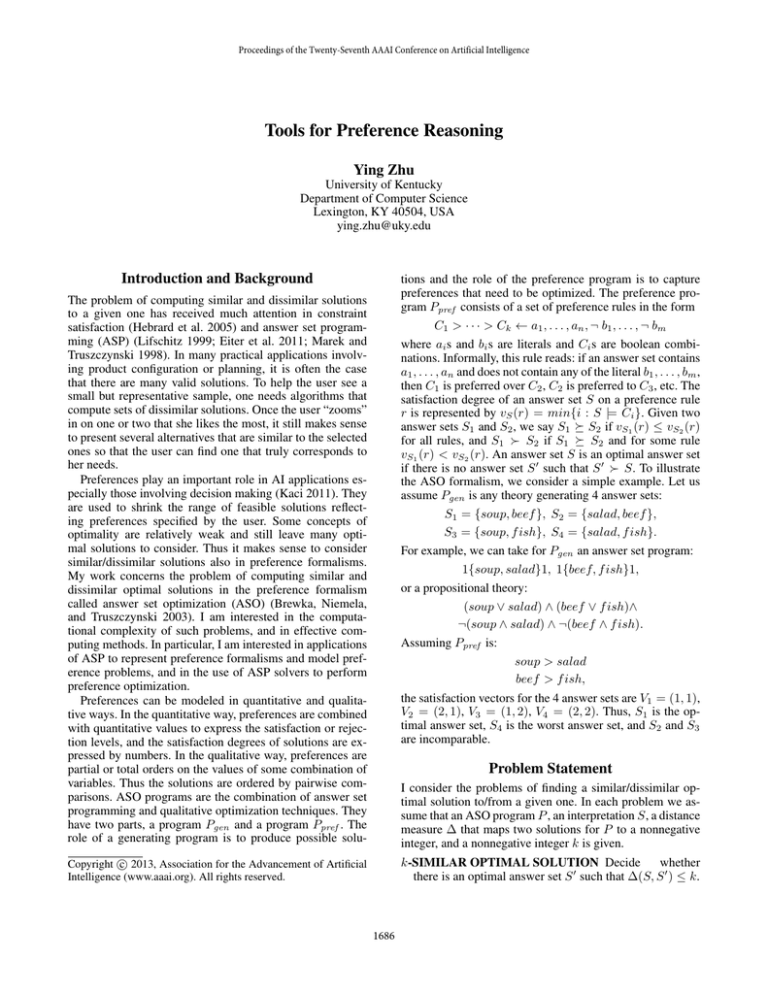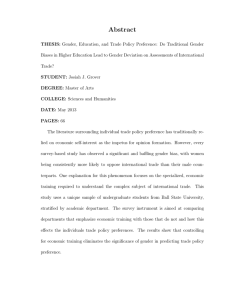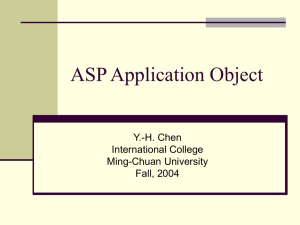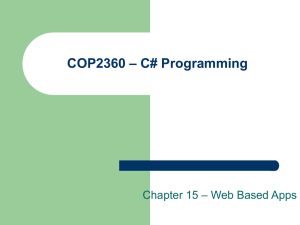
Proceedings of the Twenty-Seventh AAAI Conference on Artificial Intelligence
Tools for Preference Reasoning
Ying Zhu
University of Kentucky
Department of Computer Science
Lexington, KY 40504, USA
ying.zhu@uky.edu
Introduction and Background
tions and the role of the preference program is to capture
preferences that need to be optimized. The preference program Ppref consists of a set of preference rules in the form
C1 > · · · > Ck ← a1 , . . . , an , ¬ b1 , . . . , ¬ bm
where ai s and bi s are literals and Ci s are boolean combinations. Informally, this rule reads: if an answer set contains
a1 , . . . , an and does not contain any of the literal b1 , . . . , bm ,
then C1 is preferred over C2 , C2 is preferred to C3 , etc. The
satisfaction degree of an answer set S on a preference rule
r is represented by vS (r) = min{i : S |= Ci }. Given two
answer sets S1 and S2 , we say S1 S2 if vS1 (r) ≤ vS2 (r)
for all rules, and S1 S2 if S1 S2 and for some rule
vS1 (r) < vS2 (r). An answer set S is an optimal answer set
if there is no answer set S 0 such that S 0 S. To illustrate
the ASO formalism, we consider a simple example. Let us
assume Pgen is any theory generating 4 answer sets:
S1 = {soup, beef }, S2 = {salad, beef },
S3 = {soup, f ish}, S4 = {salad, f ish}.
For example, we can take for Pgen an answer set program:
1{soup, salad}1, 1{beef, f ish}1,
or a propositional theory:
(soup ∨ salad) ∧ (beef ∨ f ish)∧
¬(soup ∧ salad) ∧ ¬(beef ∧ f ish).
Assuming Ppref is:
soup > salad
beef > f ish,
the satisfaction vectors for the 4 answer sets are V1 = (1, 1),
V2 = (2, 1), V3 = (1, 2), V4 = (2, 2). Thus, S1 is the optimal answer set, S4 is the worst answer set, and S2 and S3
are incomparable.
The problem of computing similar and dissimilar solutions
to a given one has received much attention in constraint
satisfaction (Hebrard et al. 2005) and answer set programming (ASP) (Lifschitz 1999; Eiter et al. 2011; Marek and
Truszczynski 1998). In many practical applications involving product configuration or planning, it is often the case
that there are many valid solutions. To help the user see a
small but representative sample, one needs algorithms that
compute sets of dissimilar solutions. Once the user “zooms”
in on one or two that she likes the most, it still makes sense
to present several alternatives that are similar to the selected
ones so that the user can find one that truly corresponds to
her needs.
Preferences play an important role in AI applications especially those involving decision making (Kaci 2011). They
are used to shrink the range of feasible solutions reflecting preferences specified by the user. Some concepts of
optimality are relatively weak and still leave many optimal solutions to consider. Thus it makes sense to consider
similar/dissimilar solutions also in preference formalisms.
My work concerns the problem of computing similar and
dissimilar optimal solutions in the preference formalism
called answer set optimization (ASO) (Brewka, Niemela,
and Truszczynski 2003). I am interested in the computational complexity of such problems, and in effective computing methods. In particular, I am interested in applications
of ASP to represent preference formalisms and model preference problems, and in the use of ASP solvers to perform
preference optimization.
Preferences can be modeled in quantitative and qualitative ways. In the quantitative way, preferences are combined
with quantitative values to express the satisfaction or rejection levels, and the satisfaction degrees of solutions are expressed by numbers. In the qualitative way, preferences are
partial or total orders on the values of some combination of
variables. Thus the solutions are ordered by pairwise comparisons. ASO programs are the combination of answer set
programming and qualitative optimization techniques. They
have two parts, a program Pgen and a program Ppref . The
role of a generating program is to produce possible solu-
Problem Statement
I consider the problems of finding a similar/dissimilar optimal solution to/from a given one. In each problem we assume that an ASO program P , an interpretation S, a distance
measure ∆ that maps two solutions for P to a nonnegative
integer, and a nonnegative integer k is given.
k-SIMILAR OPTIMAL SOLUTION Decide
whether
there is an optimal answer set S 0 such that ∆(S, S 0 ) ≤ k.
c 2013, Association for the Advancement of Artificial
Copyright Intelligence (www.aaai.org). All rights reserved.
1686
Conclusion and Future Work
k-DISSIMILAR OPTIMAL SOLUTION Decide
whether there is an optimal answer set S 0 such that
∆(S, S 0 ) ≥ k.
So far I have studied the problem of computing similar or
dissimilar optimal answer sets in ASO programming, analyzed its computational complexity, and introduced offline
computing methods. My work so far demonstrates that ASP
is a convenient tool to represent preference optimization
problems and ASP solver a promising computational tool
for the preference reasoning domain.
I am currently working on online computing methods
which can find the similar/dissimilar optimal solution without computing all optimal solutions. The idea is to model the
computation of an optimal answer set, the distance function,
and the constraints on the distance into one ASP program.
This program takes the given interpretation as input and
gives a similar/dissimilar optimal answer set if it exists. The
key point is to build a program which can find an optimal
answer set in one call. To build that program, I am studying
encodings of the problem as a quantified boolean formula
(QBF). Once an appropriate QBF encoding is found, I will
use standard methods to translate it further into a disjunctive logic program (Eiter and Gottlob 1995). That will allow
me to use disjunctive ASP solvers such as claspD (Gebser
et al. 2007) and DLV (Leone et al. 2006). However, I also
intend to apply QBF solvers directly on the QBF encoding.
Once all these techniques are well developed, I will perform
extensive experiments to study their performance.
Assuming that deciding whether ∆(S, S 0 ) ≤ k for a given
k is in P, the problems
Pp to find a similar/dissimilar optimal answer set are 2 -complete. The membership can be
showed by guessing an interpretation S 0 , verifying whether
S 0 is an optimal answer set which has been proved is coNPcomplete (Brewka, Niemela, and Truszczynski 2003), and
checking whether ∆(S, S 0 ) ≤ k in polynomial time. For
the hardness, we construct a reduction from the problem to
decide whether an optimal
Pp answer set including a given literal exists, which is 2 -complete (Brewka, Niemela, and
Truszczynski 2003). The details depend on the definition of
the distance function. The theorems we present below assume that the Hamming distance is used to measure how far
from each other are the solutions.
Theorem 1. Given an ASO program P , an interpretation
S, and a nonnegative integer k, deciding whether there
Ppis
an optimal answer set S 0 such that HD(S, S 0 ) ≤ k is 2 complete.
Theorem 2. Given an ASO program P , an interpretation
S, and a nonnegative integer k, deciding whether there
Ppis
an optimal answer set S 0 such that HD(S, S 0 ) ≥ k is 2 complete.
Before talking about computing methods, I briefly introduce a method to find optimal answer sets in ASO programming. The method is based on answer set programming
(ASP) (Lifschitz 1999; Marek and Truszczynski 1998). To
get the optimal answer sets, we design a “tester” ASP program. It takes an answer set as input, and an ASP solver,
such as CLASP (Gebser et al. 2007), applied to it generates
a strictly better one if one exists. Thus, to find an optimal
answer set, we can start from an arbitrary answer set, which
can be found by an ASP solver, and use the tester iteratively,
each time taking the output of last run as the input, until it
fails. To find another optimal answer set, we first find an answer set which is not worse than the first optimal answer set,
which also can be modeled as an ASP problem and solved
by ASP solvers, and then use it as a start point to find an optimal answer set. To find all optimal answer set, we continue
until it is no longer possible to find an answer set incomparable with the optimal answer sets found so far.
Solving the problem, the offline methods compute all optimal answer sets and store them. To compute k-similar
solutions to a given interpretation U0 , the distances from
U0 to all optimal solutions are computed and the solutions
whose distances from U0 are ≤ k are reported. To compute
k-dissimilar solutions, similarly, the outcomes whose distances from U0 are ≥ k are reported.
Two important variants of these problems are to find a
set of n optimal solutions, in which the distance between
each pair of solutions is ≤ k or ≥ k. Similarly, all optimal
solutions and the distances between each pair of them are
computed and some clustering methods are used to find the
proper cluster. I do not discuss these problems here due to
space limitation.
References
Brewka, G.; Niemela, I.; and Truszczynski, M. 2003. Answer set optimization. In PROC. IJCAI-03, 867–872. Morgan
Kaufmann.
Eiter, T., and Gottlob, G. 1995. On the computational cost
of disjunctive logic programming: Propositional case.
Eiter, T.; Erdem, E.; Erdogan, H.; and Fink, M. 2011. Finding similar/diverse solutions in answer set programming.
CoRR abs/1108.3260.
Gebser, M.; Kaufmann, B.; Neumann, A.; and Schaub, T.
2007. T.: Conflict-driven answer set solving. In In: Twentieth
International Joint Conference on Artificial Intelligence (IJCAI-07,
386–392. MIT Press.
Hebrard, E.; Hnich, B.; O’Sullivan, B.; and Walsh, T. 2005.
Finding diverse and similar solutions in constraint programming. In Proceedings of the 20th national conference on Artificial
intelligence - Volume 1, AAAI’05, 372–377. AAAI Press.
Kaci, S. 2011. Working with Preferences: Less Is More. Cognitive Technologies. Springer.
Leone, N.; Pfeifer, G.; Faber, W.; Eiter, T.; Gottlob, G.; Perri,
S.; and Scarcello, F. 2006. The dlv system for knowledge representation and reasoning. ACM Trans. Comput. Logic
7(3):499–562.
Lifschitz, V. 1999. Answer set planning. 23–37. The MIT
Press.
Marek, V. W., and Truszczynski, M. 1998. Stable models and an alternative logic programming paradigm. CoRR
cs.LO/9809032.
1687





